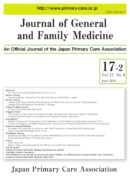17 巻, 2 号
選択された号の論文の21件中1~21を表示しています
- |<
- <
- 1
- >
- >|
-
2016 年 17 巻 2 号 p. H2
発行日: 2016年
公開日: 2016/06/18
PDF形式でダウンロード (134K) -
2016 年 17 巻 2 号 p. C2
発行日: 2016年
公開日: 2016/06/18
PDF形式でダウンロード (30K) -
2016 年 17 巻 2 号 p. E2
発行日: 2016年
公開日: 2016/06/18
PDF形式でダウンロード (31K)
Editorials
-
原稿種別: Editorials
2016 年 17 巻 2 号 p. 123-124
発行日: 2016/06/18
公開日: 2016/06/18
PDF形式でダウンロード (37K)
Special Articles
-
原稿種別: Special Articles
2016 年 17 巻 2 号 p. 125-131
発行日: 2016/06/18
公開日: 2016/06/18
PDF形式でダウンロード (84K)
Review Articles
-
原稿種別: Review Articles
2016 年 17 巻 2 号 p. 132-137
発行日: 2016/06/18
公開日: 2016/06/18
PDF形式でダウンロード (67K) -
原稿種別: Review Articles
2016 年 17 巻 2 号 p. 138-143
発行日: 2016/06/18
公開日: 2016/06/18
PDF形式でダウンロード (680K)
Clinical Problem Solving
-
原稿種別: Clinical Problem Solving
2016 年 17 巻 2 号 p. 144-150
発行日: 2016/06/18
公開日: 2016/06/18
PDF形式でダウンロード (1269K)
Original Articles
-
原稿種別: Original Articles
2016 年 17 巻 2 号 p. 151-157
発行日: 2016/06/18
公開日: 2016/06/18
PDF形式でダウンロード (564K)
Case Reports
-
原稿種別: Case Reports
2016 年 17 巻 2 号 p. 158-159
発行日: 2016/06/18
公開日: 2016/06/18
PDF形式でダウンロード (591K) -
A Case of Pyogenic Vertebral Osteomyelitis: Importance of Physical Examination for Correct Diagnosis原稿種別: Case Reports
2016 年 17 巻 2 号 p. 160-163
発行日: 2016/06/18
公開日: 2016/06/18
PDF形式でダウンロード (1020K)
Images in Clinical Medicine
-
原稿種別: Images in Clinical Medicine
2016 年 17 巻 2 号 p. 164-167
発行日: 2016/06/18
公開日: 2016/06/18
PDF形式でダウンロード (1850K) -
原稿種別: Images in Clinical Medicine
2016 年 17 巻 2 号 p. 168-169
発行日: 2016/06/18
公開日: 2016/06/18
PDF形式でダウンロード (1132K)
Preliminary Reports
-
原稿種別: Preliminary Reports
2016 年 17 巻 2 号 p. 170-173
発行日: 2016/06/18
公開日: 2016/06/18
PDF形式でダウンロード (58K)
Letters
-
原稿種別: Letters
2016 年 17 巻 2 号 p. 174-175
発行日: 2016/06/18
公開日: 2016/06/18
PDF形式でダウンロード (459K) -
原稿種別: Letters
2016 年 17 巻 2 号 p. 176-178
発行日: 2016/06/18
公開日: 2016/06/18
PDF形式でダウンロード (797K)
-
2016 年 17 巻 2 号 p. 179
発行日: 2016/06/18
公開日: 2016/06/18
PDF形式でダウンロード (27K) -
2016 年 17 巻 2 号 p. 180-183
発行日: 2016/06/18
公開日: 2016/06/18
PDF形式でダウンロード (56K) -
2016 年 17 巻 2 号 p. 184
発行日: 2016/06/18
公開日: 2016/06/18
PDF形式でダウンロード (19K) -
2016 年 17 巻 2 号 p. 185
発行日: 2016/06/18
公開日: 2016/06/18
PDF形式でダウンロード (28K) -
2016 年 17 巻 2 号 p. 186
発行日: 2016/06/18
公開日: 2016/06/18
PDF形式でダウンロード (26K)
- |<
- <
- 1
- >
- >|
